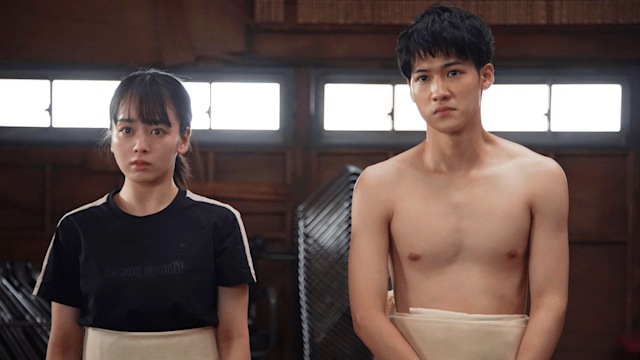Sumo wrestling, a sport steeped in history and culture, presents an intriguing paradox for many viewers: the sumo ring, known as the dohyo, appears deceptively narrow when juxtaposed with the imposing size of its competitors. Why do these grand athletes engage in combat within such a seemingly constricted space? The answer lies deep within the rich annals of tradition and ritual that envelop this ancient sport.
To grasp the essence of the dohyo and its dimensions, one must first consider its historical significance. The circle, measuring a mere 4.55 meters in diameter, represents not only the battleground for competitors but also a sacred space that has maintained its integrity throughout centuries. This intentional constriction is not merely a quirk of design; it serves numerous multifaceted purposes that transcend the material realm.
The narrowness of sumo lanes reflexively arouses questions regarding the practicality of such dimensions. How can athletes of considerable girth maneuver effectively in an environment that seems almost purposefully limiting? The answer to this challenge has less to do with the physical constraints and more with the psychological and ceremonial elements of the sport.
Each match begins with a series of ritualistic movements that emphasize balance and mental fortitude. Competitors engage in ceremonial stomping, known as shiko, not only to intimidate their opponents but also to establish a connection to the ground. The narrowness of the ring underscores the importance of stability, grounding each contender and reminding them of their roots, both physically and culturally.
Moreover, the constricted dimensions necessitate a high level of strategy and agility. Unlike other combat sports where the ring may allow wider movement, sumo wrestlers must cultivate skills that maximize their use of leverage and momentum. This restriction encourages a captivating form of dance, where each shift, pivot, and thrust is laden with intention. Thus, what may seem like a limitation transforms into a creative constraint that promotes innovation in technique and style.
In addition to practical considerations, the narrowness of the dohyo also reinforces the intense psychological dynamics of a sumo match. The proximity of the competitors accentuates the tension and adrenaline that pervade these encounters. Fans and observers are drawn into the immediacy of the contest, feeling the energy that reverberates within the sacred circle. This heightened proximity cultivates a greater sense of spectacle, enhancing the overall viewer experience.
Tradition also plays a pivotal role in defining the dimensions and significance of the sumo ring. For centuries, the design has remained remarkably consistent, embodying the passion and reverence for a sport that has transcended generations. The narrowness evokes a certain nostalgia, harkening back to the original practices of sumo as a ritualized event intended to honor the gods. In this context, the dohyo transcends its mere physical form, symbolizing a bridge between the earthly and the divine.
Additionally, the construction of the sumo ring mirrors the geometric simplicity found in many aspects of Japanese aesthetics. The circular shape of the dohyo signals completeness and unity, inviting a deeper reflection on the cyclical nature of life and competition. This design invites participants and observers alike to ponder broader philosophical themes, such as the struggle between permanence and transience. In essence, the narrow sumo lanes invite a meditative engagement with the sport that encourages introspection.
The sumo wrestling landscape is inherently intertwined with the cultural ethos of Japan. The narrowness of the ring can be seen as a representation of the Japanese value of *wa* (和), which signifies harmony and unity. In sumo, the harmonious balance between competitor and environment, strength and vulnerability, is epitomized in this confined arena. The sport highlights the delicate interplay between aggression and decorum, where the victor must not only dominate but also maintain the dignity of the tradition.
Moreover, the constricted space fosters an environment of equality among wrestlers. Sumo promotes the idea that strength alone does not guarantee victory; technique, timing, and mental acuity play equally critical roles. The limitations set by the narrow lanes compel each athlete to draw upon their skill set rather than solely relying on brute force. Herein lies a vibrant tension: the true warriors are those who can navigate space with elegance and poise, irrespective of their size.
As spectators, one finds themselves challenged to reevaluate their perspectives on space, limits, and the nature of competition. The narrowness of the sumo lanes serves as a microcosm of life itself, where boundaries can both constrain and inspire greatness. By embracing these spatial restrictions, sumo wrestlers exemplify resilience, creativity, and mastery in the face of adversity.
Ultimately, the narrow lanes of sumo wrestling illuminate the profound interplay between tradition and innovation. The dohyo, though modest in size, encapsulates the spirit of a time-honored sport that continues to adapt while honoring its rich legacy. The challenge for viewers is to engage actively with this narrative, recognizing that within the limits lies a world of potential, creativity, and shared cultural identity. In the grand arena of life, just as in the sumo ring, it is the constraints that often shape the most extraordinary accomplishments.

